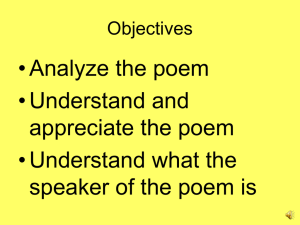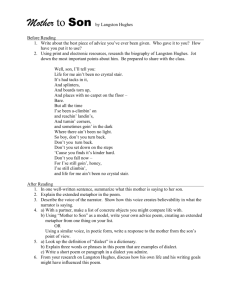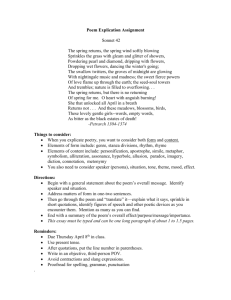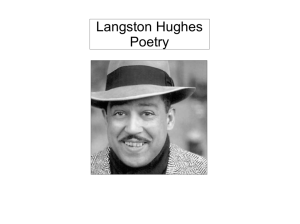Fighting Amongst Ourselves: The Civil War
advertisement
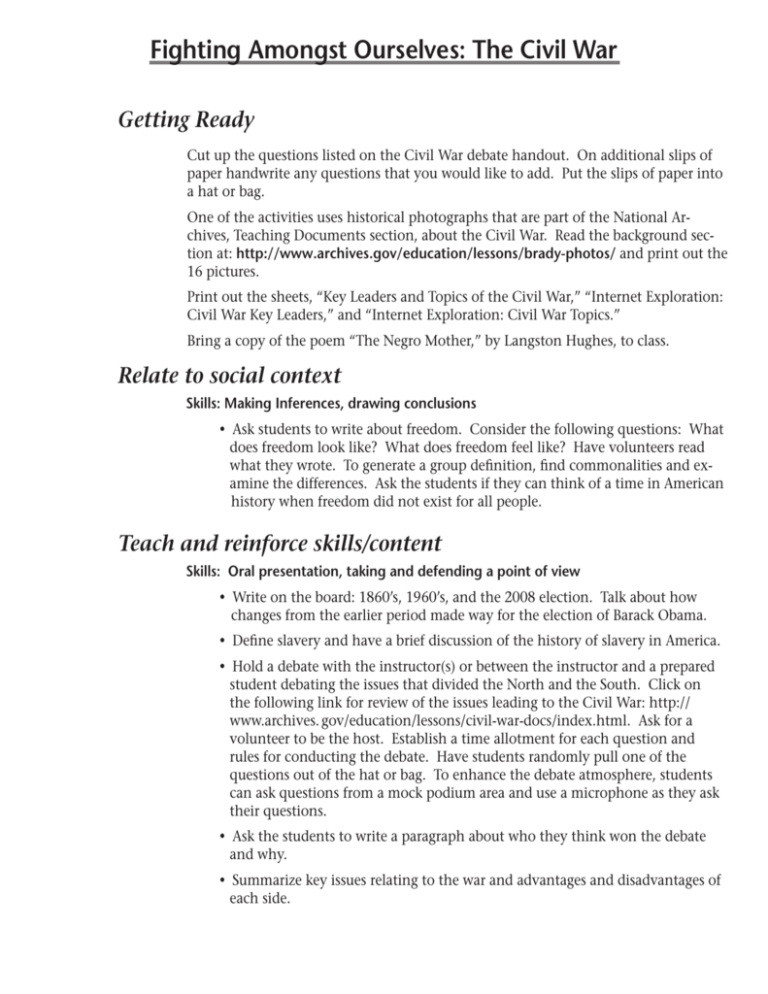
Fighting Amongst Ourselves: The Civil War Getting Ready Cut up the questions listed on the Civil War debate handout. On additional slips of paper handwrite any questions that you would like to add. Put the slips of paper into a hat or bag. One of the activities uses historical photographs that are part of the National Archives, Teaching Documents section, about the Civil War. Read the background section at: http://www.archives.gov/education/lessons/brady-photos/ and print out the 16 pictures. Print out the sheets, “Key Leaders and Topics of the Civil War,” “Internet Exploration: Civil War Key Leaders,” and “Internet Exploration: Civil War Topics.” Bring a copy of the poem “The Negro Mother,” by Langston Hughes, to class. Relate to social context Skills: Making Inferences, drawing conclusions • Ask students to write about freedom. Consider the following questions: What does freedom look like? What does freedom feel like? Have volunteers read what they wrote. To generate a group definition, find commonalities and ex- amine the differences. Ask the students if they can think of a time in American history when freedom did not exist for all people. Teach and reinforce skills/content Skills: Oral presentation, taking and defending a point of view • Write on the board: 1860’s, 1960’s, and the 2008 election. Talk about how changes from the earlier period made way for the election of Barack Obama. • Define slavery and have a brief discussion of the history of slavery in America. • Hold a debate with the instructor(s) or between the instructor and a prepared student debating the issues that divided the North and the South. Click on the following link for review of the issues leading to the Civil War: http:// www.archives.gov/education/lessons/civil-war-docs/index.html. Ask for a volunteer to be the host. Establish a time allotment for each question and rules for conducting the debate. Have students randomly pull one of the questions out of the hat or bag. To enhance the debate atmosphere, students can ask questions from a mock podium area and use a microphone as they ask their questions. • Ask the students to write a paragraph about who they think won the debate and why. • Summarize key issues relating to the war and advantages and disadvantages of each side. Skills: Analyzing primary sources • To study the Civil War in a different way, have students analyze the Brady photographs taken during that time period. These photographs are historical documents; however no actual battle scenes are depicted. 1.Assign at least two photographs to each student for analysis using the Photograph Analysis Worksheet. Assign students to one of four groups. Make sure two students in each group have analyzed the same photograph. Direct students to compare and contrast their analyses of the photographs. Once students are familiar with all the photographs, ask them to compile a list of adjectives that they think describe the life of a soldier during the Civil War. 2.Place the words that describe the life of a soldier during the Civil War around the perimeter of the classroom. Among these words intersperse copies of the 16 pictures. As the students visit the in class gallery, guide them in composing some thought-provoking questions for discussion. What motivated these men to put up with such difficult circumstances? If there had been television, would the Civil War have ended earlier or later? How did soldiers cope with the deaths of their friends and fellow soldiers? Lead a class discussion using these questions and/or those posed by students. • Distribute the “Key Leaders and Topics of the Civil War.” Ask each student to select a topic or name. Ask students to go on-line and find information about the topic or name they have selected. Distribute one of the two internet explo- ration sheets based on the student selection. Have students read first about the person or topic and then complete the worksheet. Transfer skills to new learning situations Skills: Analyzing primary sources • Share the poem the “The Negro Mother” by Langston Hughes with students. Before reading the poem, ask students what they know about Langston Hughes. Give some background information on the poet. Read the poem together and then discuss it. Who is the “Negro Mother”? Is she only one person? What experiences does she describe? How does the woman depict being a slave? The narrator describes herself as uneducated, yet the poem shows otherwise. How does Langston Hughes show us her wisdom in this poem? How would you describe the mother? Have students find descriptive words and phrases in the poem. • Ask students to identify words in the poem they do not know. Write these on the board. Give one new word to each student and have students use dictionar- ies and a thesaurus to find the definition and one or two synonyms. Have each student write the assigned word and meanings on the board. Have several stu- dents select and read aloud one sentence from the poem that contains one of the words on the board. Have each student substitute a synonym and read the line again. How does this new word sound? Does it capture what the poet intended? Talk about the richness and power of descriptive language. • Why did Langston Hughes write this poem? What is the mother’s charge to young people today? Does this message apply only to “my black children”? Why or why not? Guide reflection on what’s learned Help students review and label what they have learned during the class. Include literacy skills and content. Ask them to think about their individual accomplishments and write them down. The Civil War Debate Questions What was the Civil War? When was the Civil War? Who were the abolitionists? Each side should respond. At the start of the war, what was the North fighting for? At the start of the war, what was the South fighting for? Why did the South secede? Each side should respond. Which states joined the South? Each side should respond. What was the outcome of the war? Key Leaders and Topics of the Civil War The Dred Scott decision The Fugitive Slave Act The Quakers’ role during the Civil War Battle of Gettysburg Clara Barton Frederick Douglas Abraham Lincoln Sherman’s March Underground Railroad Turner’s Rebellion Mary Todd Lincoln Uncle Tom’s Cabin John Brown Robert E. Lee Surrender at Appomattox Ulysses Grant Sojourner Truth Theodore Parker Jefferson Davis Martha C. Wright Abolitionists Internet Exploration: Civil War Key Leaders Write the name of the person you are researching: ________________________________________ When and where was the person born? What were this person’s key accomplishments? What were the key struggles or obstacles he/she faced? What important values did this person hold? In what way do you identify with this person? Internet Exploration: Civil War Key Topics Write the name of the topic you are researching: ________________________________________ Describe the topic in your own words. What were the key issues that led up to this decision or battle? What impact do you think it had on the outcome of the Civil War? Why is this relevant in today’s world?
